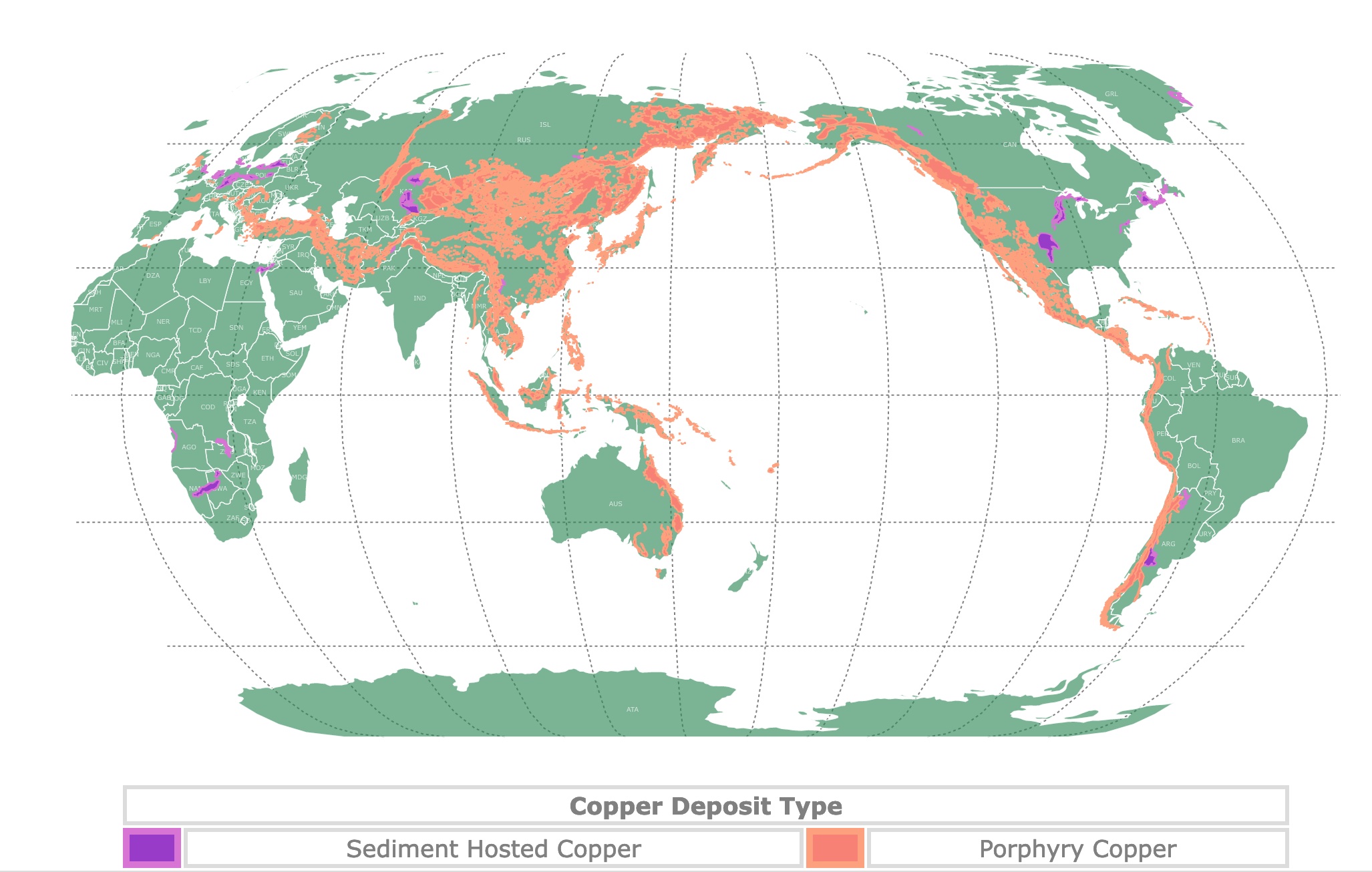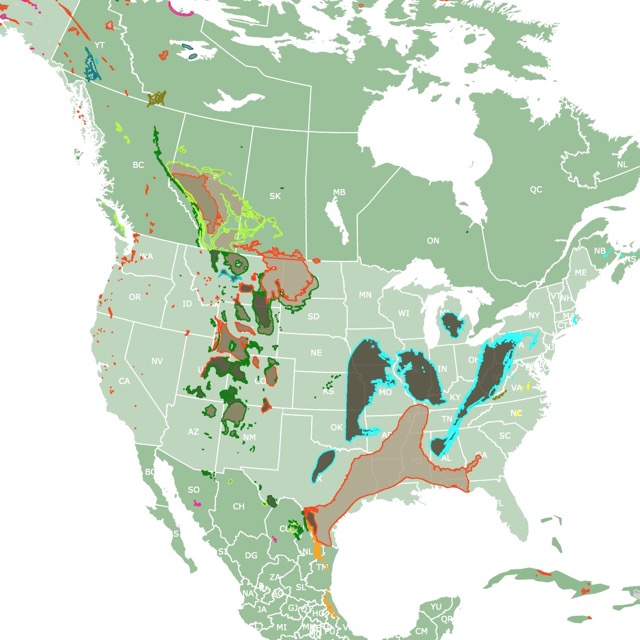Mineral Sources of Copper World Map
This map displays the world's copper and its origin. Porphyry copper is depicted in salmon. Sediment-hosted copper is purple. For more details, hover over the map. To take a closer look, zoom in. For more information, scroll down.
| Copper Deposit Type | |||
|---|---|---|---|
| Sediment Hosted Copper | Porphyry Copper | ||
WHAT IS COPPER?
Copper is a soft, malleable, reddish metal. It is the only metal besides gold that does not look silver or gray.
Copper ranks as the third-most-consumed industrial metal in the world, after iron and aluminum. This is because it conducts heat and electricity well.
Because of this, it is widely used in electronics and wiring. Furthermore, about three-quarters of the copper mined is used to make electrical wires, telecommunication cables, and electronics.
Most copper occurs in ores and must be smelted or extracted from its ore before it can be used. Source: LiveScience.
To learn more about this metal, its uses, and mines worldwide, go to copper deposits!
If you think its time to invest in copper, or other commodities, Acorns app can help. Acorns helps you invest spare change, bank smarter, and build wealth through long-term investing. To start today, Sing up here!
Classification of Copper Minerals
Copper may be classified based on its chemical composition and crystal structure.
Copper minerals have different colors, compositions, formulas, and hardness and are found in different locations. These include:
- Native Copper: This is 100% copper. It is in its pure metallic form as a nugget or wire. Copper can also occur in its pure metallic form as dendritic or wire-like structures.
- Sulfides: These are copper sulfide minerals. They include chalcopyrite (CuFeS2), 34,5% copper, the most common copper mineral. Bornite (Cu5FeS4) is 63% copper, common in hydrothermal veins with other copper minerals. Chalcocite (Cu2S), 79.8% copper, covellite (CuS), 66.5% copper, and enargite (Cu3AsS4), 48.4% copper.
- Oxides: Copper oxide minerals include cuprite (Cu2O), 88.8 % copper, and tenorite (CuO), 79% copper.
- Carbonate minerals: These include malachite, 57.3% copper, and azurite, 55% copper. They are both formed by weathering of copper deposits.
- Silicates: Silicate minerals include chrysocholla, 37.9% copper, and dioptase, 40.3% Cu.
The most common source of copper ore is the sulfide ore mineral chalcopyrite. It accounts for 50% of copper production.
Chalcocite has been mined for centuries, and is one of the most profitable copper ores. This is thanks to its high copper content, and the ease at which it can be separated from sulfur. Soruce: Investigating News.
These minerals can be found in various geological settings, including porphyry copper deposits, volcanic-hosted massive sulfide deposits, sediment-hosted copper deposits, and skarn deposits.
You can buy chrysocolla on Amazon. You can find it as Chrysocolla tumbled & hand polished .
You can also get Malachite on Amazon. You will find it as GeoFossils Malachite Large Tumbled Stone.
Copper Mineral Formation
Copper is an abundant element on Earth's crust. It is estimated that copper concentration is 50 parts per million.
Several factors affect copper mineral formation.
Geological structures like faults and fractures provide pathways for copper deposit minerals.
Tectonic activity is often associated with copper mineralization. In these areas, magma can be transported to the Earth's surface.
Copper mineralization is also associated with hydrothermal activity. High temperatures and high-pressure conditions facilitate the deposition of copper minerals.
Finally, the longer a mineralizing system is active, the greater the opportunity for copper minerals to accumulate and form economically viable deposits.
Geologic Mineralization of Copper
Copper mineralization commonly occurs in the following settings.
Porphyry Copper Deposits
Porphyry Copper deposits account for 60% of the world's copper. They include other metals like gold, silver, gold, and molybdenum.
Porphyry copper is characterized by its low grade and high tonnage. They typically contain between 0.4 and 1 percent copper.
A porphyry is not a rock type but a rock with a particular texture. This porphyritic rock has large feldspar crystals in a finer-grained matrix.
Porphyry copper deposits form along convergent plate margins. This is confirmed by the map above.
As the oceanic crust is consumed by the mantle, it begins to melt. This melting of the crust creates magma that is less dense than the overlying continental crust.
The intrusions interact through large conduits known as faults, assimilating or absorbing material from the Earth’s crust along the way.
Magma can produce hydrothermal fluid that interacts with the surrounding rocks and rises to the surface. This fluid changes the chemistry of the surrounding rock either by adding new elements or removing elements.
Its composition is based on the temperature and pH of the conditions from which the minerals were created.
Parts of the intrusion that are enriched in the fluid can produce the porphyritic-textured rocks for which porphyry deposits are named. Source: Geology for Investors.
Porphyry Copper Deposits Location
The majority of porphyry coppers are associated with younger (250-30 Million years ago) volcanic belts around the Pacific plate boundaries.
The biggest mines are in Chile, Utah, and Indonesia. The deposits along the Pacific coast of North and South America are associated with plate subduction.
The more gold-rich deposits in Indonesia and Papua New Guinea are associated with island arc volcanism behind the subduction zone.
To learn more about copper geology, Amazon has Advances in Geology of the Porphyry Copper Deposits: Southwestern North America. This book has thorough explanations of copper geology.
Learning about metals and deposits does not make you richer, but buying and selling stocks will. Round up the purchase of everything you spend, up to the nearest dollar. Acorns will help you invest it. Download the app here!
Sediment-Hosted Copper Deposits
These deposits are often overlooked. Nevertheless, they account for 20% of global copper production.
Sediment-hosted copper deposits are also a source of silver and cobalt.
Unlike porphyry copper deposits, sediment-hosted copper deposits are related to oxidized sandstone formations (redbeds). These are located in large sedimentary basins in the interiors of continents.
These deposits occur within sedimentary rocks deposited in former marine or lake environments.
Copper is usually associated with shale, sandstone, and carbonate rocks, and the deposits can be in arranged layers.
Sediment-hosted deposits occur worldwide, except Antarctica. Most of these deposits are found in Africa and Central Europe. Soruce: Geology for Inv.
Volcanogenic Massive Sulfide Deposits
These are typically small to medium-sized deposits that form at or near the seafloor in volcanic or sedimentary rocks.
They are characterized by high grades of copper, zinc, lead, and other metals. They are often associated with hydrothermal vents on the seafloor.
Iron Oxide-Copper-Gold (IOCG)
Iron oxide-copper-gold (IOCG) ore deposits are highly valuable concentrations of copper, gold and uranium ores.
Copper Skarns
Skarns are metamorphic rocks affected by hot and chemically active fluids that flow through the rocks. They occur at the edges of magma bodies.
Skarn deposits are usually characterized by high grades of copper, as well as significant amounts of other metals such as gold, silver, and molybdenum.
Copper Oxide deposits
These deposits are usually found near the surface. They are formed by weathering and oxidation of copper sulfide minerals.
They usually occur in arid or semi-arid regions.
In these areas, copper minerals are filtered from the rocks by acidic groundwater and accumulate in copper oxide minerals. Source: Geo Science.
Resources for Copper Geology Map
The data to create the map with undiscovered copper resources is from Dicken, C.L., Dunlap, Pamela, Parks, H.L., Hammarstrom, J.M., and Zientek, M.L., 2016, Spatial database for a global assessment of undiscovered copper resources: U.S. Geological Survey Scientific Investigations Report 2010–5090–Z, 29 p., and GIS data, available at http://dx.doi.org/10.3133/sir20105090Z. The shapefiles were downloaded from USGS.
The shapefiles with the countries of the world were obtained from Natural Earth.
This map will be updated with new data! To receive updates on this and more nature maps, join my email list!!!!!!!
Made by Luz K. Molina with D3.js.










